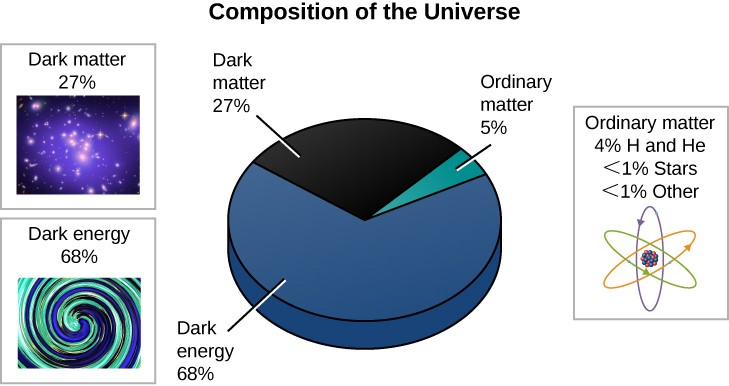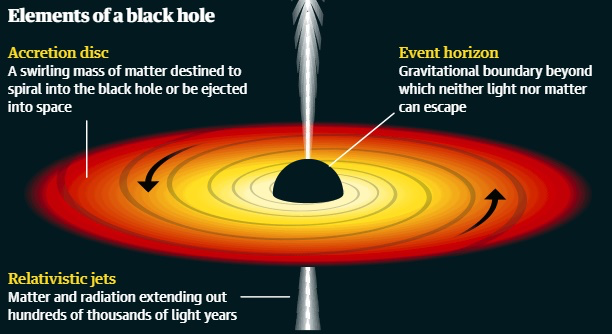Science & Technology
Dark Matter Shapes Galaxies
- 22 Jan 2022
- 7 min read
For Prelims: Dark Matter, Large Hadron Collider, dark energy, Black Hole
For Mains: Dark Matter, Dark energy, Black Hole, Expansion of Universe
Why in News
Recently, scientists investigating how the shape of dark matter affects the motion of stars in the centre of some galaxies (stellar bars) have found that out-of-plane bending can be explained through dark matter halos in barred galaxies.
- Out of plane bending of the bar in barred galaxies is a rare violent bar thickening mechanism known as buckling.
- A dark halo is the inferred halo of invisible material (dark matter) that permeates and surrounds individual galaxies, as well as groups and clusters of galaxies.
Note
- A barred spiral galaxy is a spiral galaxy with a central bar-shaped structure composed of stars.
- For example, the Milky Way is a disk galaxy made up of stars moving in circular orbits around the center in a flattened disk, with a dense collection of the stars at the center called the bulge.
- These bulges can have shapes ranging from nearly spherical to as flat as the galaxy disk. The Milky Way has a flat boxy or peanut-shaped bulge in its center.
- Such bulges are formed due to thickening of the stellar bars in galaxies.
- One of the violent thickening mechanisms is buckling, where the bar bends out of the plane of the galaxy disk.
- Stellar bar: A bar-shaped accumulation of stars in galaxies.
Key Points
- About Dark Matter:
- Dark matter, though never detected, is believed to be present in the entire universe.
- It is presumed that primordial black holes, those that were formed in the early age of the universe, are a source of dark matter. It was proposed by Professor Stephen Hawking.
- It is believed that combined with dark energy, it makes up more than 95% of the universe.
- Its gravitational force prevents stars in our Milky Way from flying apart.
- However, attempts to detect such dark matter particles using underground experiments, or accelerator experiments including the world's largest accelerator, the Large Hadron Collider (LHC), have failed so far.
- Dark Matter Presence in the Universe:
- Laws of gravity expect us to see stars closer to the center of galaxies rotating faster than the stars on the edge.
- However, in most galaxies, the stars closer to the center and the stars at the edge of the galaxies take almost the same time to make one revolution.
- This implied that something invisible and enveloping the galaxies was giving an extra push to the outer stars, speeding them up.
- This entity has remained as one of the unresolved puzzles in cosmology since the 1930s. It was named `Dark Matter’.
- The material is considered to be a ‘matter’ since it has gravitational attraction and it is ‘dark’ because it does not seem to interact with light (or any part of the electromagnetic spectrum).
- Laws of gravity expect us to see stars closer to the center of galaxies rotating faster than the stars on the edge.
- Dark Matter and Dark Energy:
- While dark matter attracts and holds galaxies together, dark energy repels and causes the expansion of our universe.
- Despite both components being invisible, a lot more is known about dark matter, since its existence was suggested as early as the 1920s, while dark energy wasn’t discovered until 1998.
- About Dark Energy:
- The Big Bang occurred nearly 15 billion years ago and expanded.
- Earlier, astronomers believed that eventually the expansion of the Universe will slow down because of gravity and it will recollapse.
- However, data from the Hubble Telescope suggested that the Universe's expansion is accelerating.
- The astronomers theorize that the faster expansion rate is due to a mysterious, dark force or energy that is pulling galaxies apart.
- The term ‘dark’ is used to denote the unknown.
- The following diagram reveals changes in the rate of expansion since the universe's birth 15 billion years ago.
Black Holes
- It refers to a point in space where the matter is so compressed as to create a gravity field from which even light cannot escape.
- The concept was theorized by Albert Einstein in 1915 and the term ‘black hole’ was coined in the mid-1960s by American physicist John Archibald Wheeler.
- Usually, the black holes belong to two categories:
- One category ranges between a few solar masses and tens of solar masses. These are thought to form when massive stars die.
- The other category is of supermassive black holes. These range from hundreds of thousands to billions of times that of the sun from the Solar system to which Earth belongs.
- In April 2019, the scientists at the Event Horizon Telescope Project released the first-ever image of a Black Hole (more precisely, of its shadow).
- The Event Horizon Telescope is a group of 8 radio telescopes (used to detect radio waves from space) located in different parts of the world.
- Gravitational waves are created when two black holes orbit each other and merge.








